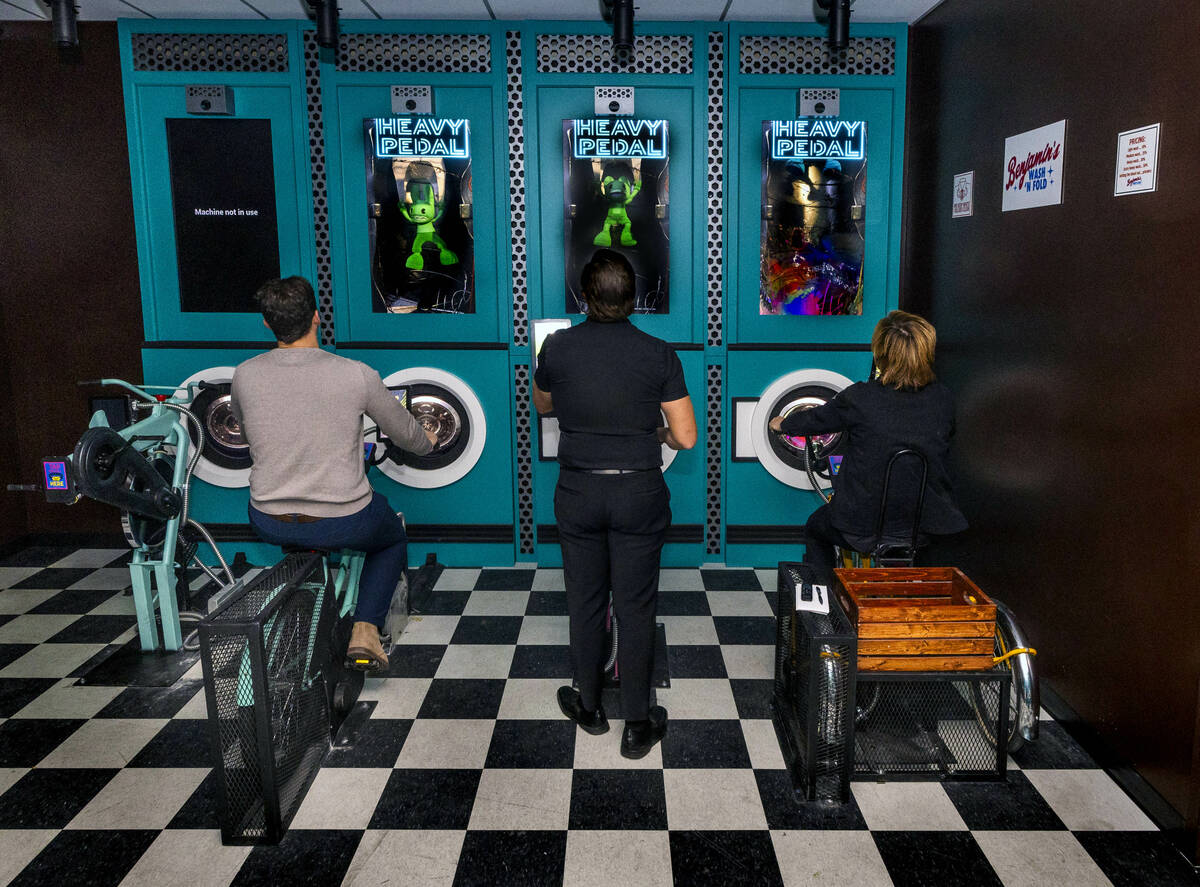‘Synthetic superstars’ of TikTok fame inspire new Area15 attraction
The heavy metal laundromat awaits.
“Welcome to our first test room: Heavy Pedal,” a disembodied voice with a British accent greets us upon entry. “Both a nod to the musical preference of sadists, and an indication that this test will involve pedaling.”
Stationary bikes are arrayed around us, facing washing machines topped by video screens that illuminate our dimly lit surroundings with a turquoise glow.
Soon, Pantera’s “Walk” — a fight song for the ages — will roar from the speakers like a lion that’s swallowed a bullhorn.
But first, some instructions.
“Let’s begin,” the voice says after we scan our wristbands and climb aboard our bikes or man a hand crank instead. “While your personal experiences with dopamine release may be limited to the digitally induced variety, physical actions have been known to trigger the delicious neurotransmitter, too.”
Our visit to the new Dopeameme Institute for Pleasure Research (D.I.P.R.) at Area15 has officially begun.
We’ve entered the first of seven rooms that make up this 40-minute experience from the minds behind Superplastic, the hugely popular animated character universe launched on social media and led by “synthetic superstars” Janky, Guggimon and others, who have over 22 million followers on TikTok, YouTube and Instagram.
And now, it’s time to pedal.
As we do so, a social media scroll appears on the screen before us in addition to one of Superplastic’s Lil Helpers, a cute, demented cartoon minion who floats on a makeshift parachute above a fan.
“As you pedal, it blows them up,” explains our tour guide, Jennifer van Dijk, Superplastic’s CEO. “If you don’t pedal fast enough, it sucks them into the fan.”
“And so you get to decide, do I want to see the scroll,” van Dijk continues. “Or do I want to kill the Lil Helper? It just depends who you are.”
We finish with a kill count of five.
“Please stop dawdling,” the disembodied voice soon commands, “and make your way to the next room.”
From TikTok to real life
“This one is part prison visitor center, part beauty salon.”
Combined at last!
“The idea here is that it’s a lie detector test,” van Dijk says from the center of a room dominated by a bank of phone booths — the kind you use to speak with your incarcerated uncle — framed by makeup mirror-style lights.
How it works: You pick up the phone, put your hand in a small box with two buttons inside and answer a series of questions clicking one of said buttons to indicate your choice.
If you “lie,” a Lil Helper meets his demise on the screen before you. Tell the truth, and he lives.
“Every room is really about things that elicit dopamine: exercise, telling the truth, dancing, messing with people,” van Dijk notes. “It’s very interactive, but also very story-driven, which was the whole goal for us.”
Why center everything around dopamine?
Van Dijk explains: “The whole concept is that our two main characters, Janky and Guggimon, they’re schemers, so the whole structure is that this is their next get-rich-quick scheme. The idea is that they’ve taken over a back alley in a building in Queens to create what is their next scheme, which is the Institute for Pleasure Research, where they want to take your dopamine and sell it back to you.”
About those characters: They’re huge, their popularity boosted after they became playable skins in smash video game “Fortnite.”
Janky, a catlike presence, and Guggimon, who looks kind of like a malevolent rabbit with serrated shark’s teeth, are a mischievous pair with an “Itchy and Scratchy”-esque relationship, playing pranks on each other in animated clips featured on Instagram and other online outlets.
“Our whole business philosophy was to get them popular with an audience on social media, and the way we did that was by treating them as virtual influencers or synthetic celebrities,” van Dijk says. “They aren’t like ‘The Simpsons’ that live in a world that can be anywhere, Springfield, USA. They live in our world. They engage with our brand. They walk our fashion shows. They have friends in our world.
“They’re so popular online, well now you reach a point where you kind of want to go on adventures with them or see them have adventures and lives and escapades,” she continues. “And so this became a natural extension: Let’s literally bring them into the real world.”
Vegas: ‘Where else would we be?’
The vibe: Think “The Shining” in a bathroom.
We’ve entered Private Dancer, the final room we’ll explore.
There are nine stalls here, the deep-red decor suggestive of the set design of the aforementioned Stanley Kubrick horror classic, each with its own video screen where characters lead you in a series of dance moves behind a closed door.
When your time is up here, you enter the experience-ending Control Room, where you can scan your wristband, download pictures taken of you during your visit and get a dopamine “prescription” as well as suggested items to purchase in the gift shop, which is loaded with Superplastic collectibles.
Superplastic initially sought to open its own place in New York City in a nod to the company’s East Coast origins. But then it discovered Area15.
“It’s like Burning Man and a mall had a baby — and it was an incredible baby,” van Dijk says of her initial impression of the art and entertainment complex. “It was like, ‘Oh, my God, this is perfect. Where else would we be?’ ”
Despite the company’s popularity online, she’s aware that Superplastic will still be foreign to some, which played into their thinking when creating Dopeameme.
“We know that 90-plus percent of the people that will walk through these doors probably don’t know who we are,” van Dijk says. “So, we also know that we had to have something that connected universally, and people could come in and learn about us and still have a good time.
“Now, if you know about us, sure, you know these characters are schemers and stuff like that,” she continues. “But even if you don’t, you’re gonna learn.”
The end result is a clever, have-your-cake-and-eat-it-too concept, bringing online characters into a real-life, experiential context while playfully poking fun at the very social media habits that have made them stars.
Is it satire?
Is it sincere?
Yes and yes.
“The underlying theme is, ‘We might be messing with you, or we might be serious,’ ” van Dijk says, before encapsulating Dopeameme’s ultimate aim. “You’re not trying to win a game here. You’re trying to just have fun.”
Contact Jason Bracelin at jbracelin@reviewjournal.com or 702-383-0476. Follow @jasonbracelin76 on Instagram.



































